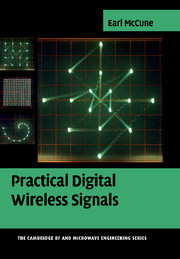Book contents
- Frontmatter
- Contents
- Preface
- Definitions and acronyms
- Terminology and notation
- 1 Keying, states, and block diagram construction
- 2 Common issues and signal characterization
- 3 Important details on results from Shannon, Nyquist, and others
- 4 Digital amplitude modulation (ASK)
- 5 Digital frequency modulation: FSK
- 6 Digital phase modulation: PSK
- 7 Combined digital modulations: QAM and OFDM
- 8 Spread spectrum
- 9 Wireless propagation and antenna fundamentals
- 10 Principles of coding
- 11 Multiple access techniques
- 12 Signal tradeoffs and system evolution
- Tutorial Appendices
- Index
- References
3 - Important details on results from Shannon, Nyquist, and others
Published online by Cambridge University Press: 04 August 2010
- Frontmatter
- Contents
- Preface
- Definitions and acronyms
- Terminology and notation
- 1 Keying, states, and block diagram construction
- 2 Common issues and signal characterization
- 3 Important details on results from Shannon, Nyquist, and others
- 4 Digital amplitude modulation (ASK)
- 5 Digital frequency modulation: FSK
- 6 Digital phase modulation: PSK
- 7 Combined digital modulations: QAM and OFDM
- 8 Spread spectrum
- 9 Wireless propagation and antenna fundamentals
- 10 Principles of coding
- 11 Multiple access techniques
- 12 Signal tradeoffs and system evolution
- Tutorial Appendices
- Index
- References
Summary
In Chapter 2, only introductory level details are presented for the many concepts listed. There are a few of these concepts that warrant a much more detailed discussion in this book. Usually this is because there is significant confusion on these topics even among well-experienced engineers, so that any new engineer to DWC technology is guaranteed to be even more confused. More often, however, I have found that many important aspects are simply missed in the literature – for example, the fact that the raised-cosine Nyquist filter is nearly the worst performing Nyquist filter option available.
DWC channel capacity – the fundamental work of Claude Shannon
In the middle of the twentieth century, Claude E. Shannon examined the theoretical capacity limit of a noise limited digital communications channel. From this work to today, the digital communications community has developed a set of “basic understandings” that, while being technically correct, contain enough unstated assumptions to lead to incomplete understandings. In this section the fundamental result of Shannon, as it has been further refined over the years, is examined in a number of different ways.
In 1948 Claude Shannon put forward a theorem, sometimes referred to as the Fundamental Theorem on Information Theory, which can be stated as [1]: (here repeated from Section 2.7)
Given a discrete memoryless channel (meaning that each signal symbol is perturbed by noise independently of the noise effects on all other symbols) with capacity C bits per second, and an information source with rate R bits per second where R < C, there exists a code such that the output of the source can be transmitted over the channel with an arbitrarily small probability of error. [emphasis added]
- Type
- Chapter
- Information
- Practical Digital Wireless Signals , pp. 74 - 101Publisher: Cambridge University PressPrint publication year: 2010



